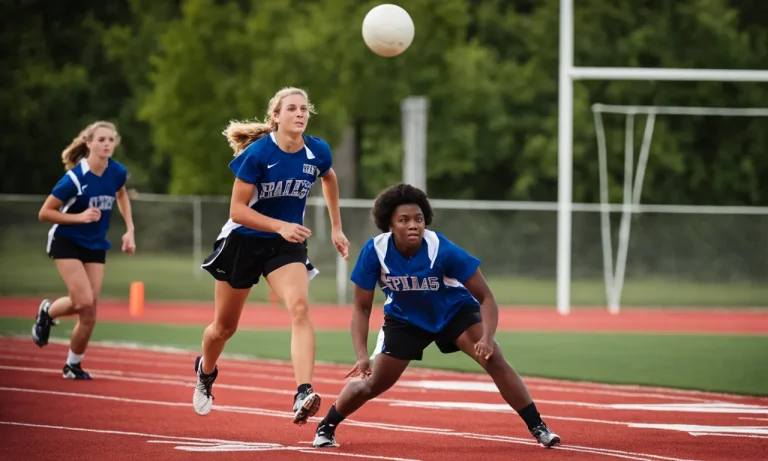Track and field is one of the most popular sports in high schools across the United States. If you’re looking to learn more about this exciting sport, you’ve come to the right place.
If you’re short on time, here’s a quick answer to your question: Track and field in high school refers to the competitive sport consisting of athletic contests based on running, jumping, and throwing.
High school track and field events are divided into sprints, middle and long-distance running events, hurdling, relays, jumps, throws, and combined events.
In this comprehensive guide, we’ll cover everything you need to know about high school track and field, including the history of the sport, the different track and field events, important rules and regulations, what skills are needed, and what a typical high school track and field season looks like.
History and Origins of High School Track and Field
Track and field events through history
The history of track and field can be traced back to ancient times, where it was a part of the ancient Greek Olympic Games. These games included events like running, jumping, and throwing. Over the centuries, track and field evolved and gained popularity, becoming a prominent sport in various cultures around the world.
Today, track and field events include sprints, distance running, hurdles, long jump, high jump, shot put, discus throw, and javelin throw, among others.
View this post on Instagram
When track and field became a high school sport
Track and field became a recognized sport in high schools in the late 19th century. As education systems developed and physical education gained importance, schools started to introduce track and field as a part of their athletic programs.
This allowed students to showcase their athletic abilities and compete against other schools. The popularity of high school track and field grew rapidly, and it soon became a staple of the school sports calendar.
Governing bodies overseeing high school track and field
Various governing bodies oversee high school track and field competitions to ensure fair play and uniformity across different schools and regions. In the United States, the National Federation of State High School Associations (NFHS) is the primary governing body for high school sports, including track and field.
The NFHS establishes rules and regulations, organizes state championships, and promotes the sport at the high school level.
In addition to the NFHS, individual states and districts may have their own governing bodies that oversee high school track and field. These bodies work in conjunction with the NFHS to provide guidance, support, and organization for track and field events at the local level.
Track and Field Events in High School
In high school, track and field is a popular sport that offers a variety of events for athletes to showcase their speed, endurance, strength, and agility. These events are not only physically demanding but also require discipline, dedication, and teamwork.
Let’s explore some of the main track and field events that high school students can participate in:
Sprints (short distances)
Sprints are the shortest and fastest track events, typically ranging from 100 to 400 meters. Athletes competing in sprints need explosive speed and excellent acceleration. Some of the most exciting sprint events include the 100-meter dash, 200-meter dash, and 400-meter dash.
These events are all about who can cross the finish line in the shortest amount of time and are often the highlights of track meets.
View this post on Instagram
Middle distances
Middle distance events in high school track and field usually range from 800 to 1500 meters. These races require a balance of speed and endurance. Athletes participating in these events must maintain a steady pace while conserving energy for a strong finish.
The 800-meter run and the 1500-meter run are popular middle distance events that test an athlete’s ability to maintain a fast pace over a longer distance.
Long distances
Long distance events in high school track and field are typically races that exceed 1500 meters. These events demand exceptional endurance and mental toughness. The 3000-meter run and the 5000-meter run are examples of long distance events that challenge an athlete’s stamina and ability to maintain a consistent pace for an extended period of time.
Hurdles
Hurdle events require athletes to sprint and jump over a series of hurdles set at specific distances apart. High school track and field offers both 110-meter and 300-meter hurdle events. Athletes competing in these events must possess speed, agility, and the ability to clear the hurdles without losing momentum.
Relays
Relay events in high school track and field involve a team of four runners passing a baton to each other in a designated area. The most common relay events are the 4×100-meter and 4×400-meter relays. These events not only require individual speed but also demand seamless baton exchanges and excellent teamwork.
Jumps
Jumping events in high school track and field include the long jump, high jump, and triple jump. Athletes participating in these events showcase their explosive power, technique, and coordination. These events require athletes to jump as far or as high as possible, with the distance or height determining the winner.
Throws
Throwing events in high school track and field consist of shot put, discus throw, javelin throw, and hammer throw. Athletes competing in these events must possess strength, technique, and precision. The objective is to throw the implement as far as possible, with the longest distance determining the winner.
Combined events
High school track and field also offers combined events, such as the decathlon for boys and the heptathlon for girls. These events test an athlete’s versatility across multiple disciplines, including sprints, jumps, throws, and middle-distance races.
Participants accumulate points based on their performances in each event, and the athlete with the highest total score is declared the winner.
Important Rules and Regulations
Event rules
In track and field, there are specific rules and regulations that govern each event to ensure fair competition. Athletes must adhere to these rules to avoid disqualification. For example, in sprinting events, false starts are strictly prohibited, and any athlete who commits a false start will be disqualified.
In jumping events like the long jump or high jump, athletes must take off from behind the foul line to have their attempt counted. These rules are in place to maintain the integrity of the sport and provide a level playing field for all competitors.
Equipment regulations
Track and field also has strict regulations regarding the equipment used during competitions. Athletes must use approved footwear that meets specific standards to prevent unfair advantages. For example, athletes cannot wear shoes with spikes that exceed a certain length, as this could potentially damage the track surface.
Additionally, throwing implements such as javelins or shot puts must meet weight and size requirements to ensure safety and fairness.
Track specifications
The track itself must meet specific specifications to be considered suitable for competition. The standard track is 400 meters in length and consists of eight lanes. The surface should be made of materials that provide optimal traction and allow for fast running speeds.
The dimensions of the track and the quality of its surface play a crucial role in determining the outcome of races and ensuring fair competition.
View this post on Instagram
Qualifying standards
In high school track and field, there are often qualifying standards that athletes must meet to participate in certain events or advance to higher levels of competition. These standards are set to ensure that only the most skilled athletes compete at the highest levels.
Athletes must achieve specific times, distances, or heights in their respective events to meet these standards and have the opportunity to compete against the best.
Competition formats
Track and field competitions can take various formats, depending on the level of competition and the specific event. One common format is the dual meet, where two teams compete against each other. Another format is the invitational meet, which involves multiple teams from different schools competing against each other.
There are also championship meets, such as district, regional, and state championships, where athletes have the opportunity to compete for titles and advance to higher levels of competition. Each format has its own set of rules and regulations that athletes and teams must follow.
Skills and Training
Track and field in high school requires a combination of various skills and specific training to excel in different events. Here are some key areas that athletes focus on:
Speed
Speed is a crucial skill in track and field, as it determines how quickly an athlete can cover a certain distance. Sprinters, for example, train extensively to improve their acceleration and top speed. They work on explosive starts, proper running form, and techniques to maximize their velocity.
Endurance
Endurance is crucial for athletes participating in longer distance events like the 800m, 1500m, and cross country. These athletes focus on building both aerobic and anaerobic endurance through a combination of long runs, interval training, and tempo runs.
Developing endurance allows athletes to maintain a steady pace and finish strong.
Power
Power is required for explosive movements like jumps and throws. High jumpers, for example, need to generate enough power to clear the bar, while shot putters rely on power to launch the shot as far as possible.
Athletes work on building strength and explosiveness through weightlifting, plyometric exercises, and specific event drills.
Flexibility and Mobility
Flexibility and mobility are essential for all track and field athletes to prevent injuries and optimize performance. Stretching exercises and mobility drills help athletes maintain a full range of motion, improve muscle elasticity, and enhance overall movement efficiency.
Technical Skills for Events
Each track and field event requires specific technical skills. For example, high jumpers need to master the Fosbury Flop technique, while hurdlers must perfect their hurdling form. Athletes work closely with coaches to refine their technique, focusing on body positioning, timing, and execution of specific event-related skills.
Tactical Approaches
Track and field also involves strategic thinking and tactical approaches. Athletes need to understand race strategies, such as when to make a move, how to position themselves in a pack, and when to unleash a finishing kick.
Coaches play a vital role in guiding athletes in developing effective race tactics based on their strengths and the competition.
View this post on Instagram
The High School Track and Field Season
Key dates and championships
The high school track and field season is an exciting time for athletes, coaches, and fans alike. It typically begins in the spring and lasts for several months, culminating in various regional and state championships.
These championships provide a platform for athletes to showcase their skills and compete against the best in their respective events. Some of the key dates to be aware of include the start of the season, the district championships, the regional championships, and ultimately, the state championships.
Typical weekly schedule
A typical weekly schedule during the high school track and field season involves a combination of practices and meets. Athletes usually train for their specific events during practice sessions, which can take place multiple times a week.
These practices focus on improving technique, building strength and endurance, and refining skills. In addition to practices, athletes also participate in meets, where they compete against other schools and athletes.
These meets serve as opportunities for athletes to test their abilities and strive for personal records.
Offseason training
Offseason training plays a crucial role in the success of high school track and field athletes. During the offseason, athletes have the opportunity to focus on strength and conditioning, as well as address any weaknesses in their performance.
Many athletes engage in cross-training activities, such as weightlifting, running, or participating in other sports, to maintain their fitness levels and improve overall athleticism. Offseason training can also involve working with coaches or trainers to develop specific skills and techniques necessary for success in track and field.
College recruitment
The high school track and field season is an important time for athletes who aspire to compete at the college level. College recruiters often attend major meets and championships to identify talented athletes who may be a good fit for their programs.
Athletes who perform well during the season and achieve impressive results have a greater chance of attracting the attention of college coaches. It is important for athletes to showcase their abilities, maintain good academic standing, and actively communicate with college coaches to increase their chances of securing a scholarship or a spot on a college track and field team.
Conclusion
Track and field has been a popular high school sport for over a century, with thousands of student-athletes taking part each year. The variety of events provides opportunities for athletes of all abilities to challenge themselves and compete.
While track and field requires dedication and hard work, the lessons athletes learn about discipline, teamwork, goal-setting, and personal growth can be life-changing. Hopefully this guide gave you a good overview of what high school track and field entails.
Enjoy learning more about this storied sport!






